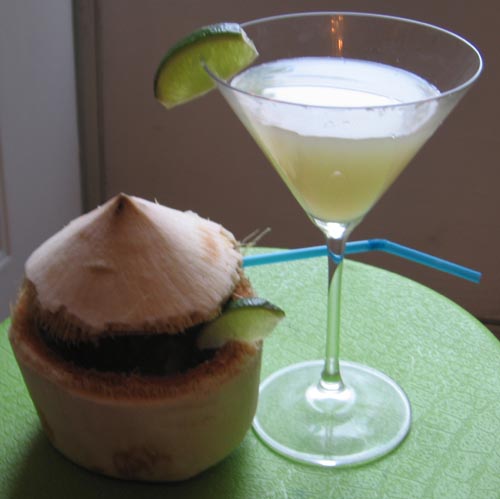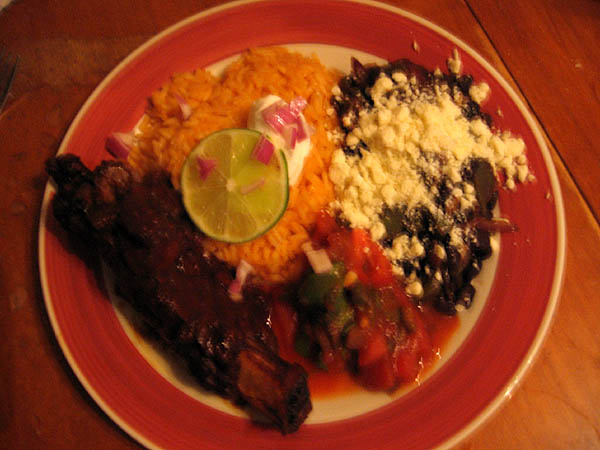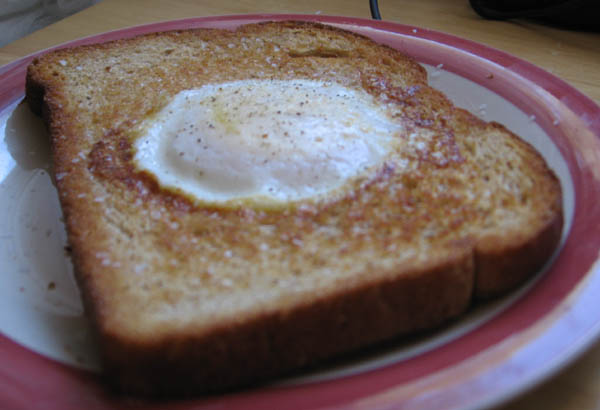Today we'll be enjoying crepes with the flavor of coconut in its various forms: coconut water, coconut milk, and the coconut flesh. I wasn't planning on cooking Vietnamese dishes this time around, but the coconut theme just led me there, paired fittingly with some French inspirations.
For the savory crepe, we have
banh xeo, the Vietnamese rice crepe, though also called "Saigon pancake." Traditionally, the filling contains shrimp and pork that has simply been steamed or sauteed. I prepared my banh xeo with lightly battered coconut shrimp. This dish is eaten by tearing off pieces of lettuce and wrapping pieces of the crepe with herbs and dipping in nuoc cham, dipping fish sauce.
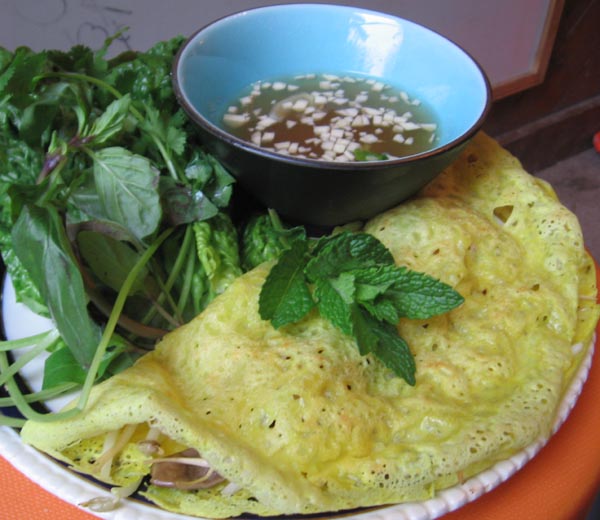
Dessert features crepes stuffed with a coconut mung bean pudding. Serve with homemade coconut ice cream and for a nice crunch a macaroon and a fried slice of banana. Wash everything down with a coconut lemongrass cocktail.
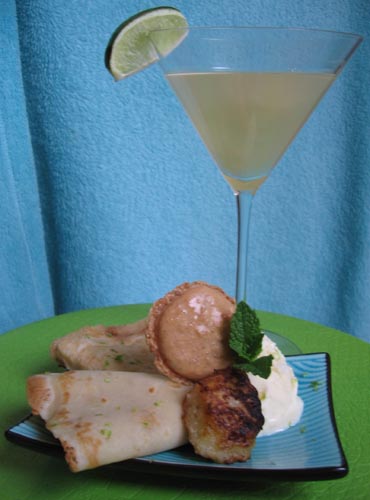
A few components of these dishes can be prepared a number of days ahead of time, so I'll start there. First, there is the handling of the coconut. I bought a young coconut with the husk removed from an Asian grocery store. When choosing coconuts, look for one that feels very heavy with the juice and with eyes that are still intact. Shaking is a good way to determine if the coconut is full or dry.
Hold the coconut over a wide bowl to capture the juice. Open up the coconut by whacking around the perimeter of the coconut with the blunt side of a large knife. A cleaver would be great for this, but I do not own one. Don't be shy and hit the coconut with a good deal of force. When the coconut cracks, pull the two halves apart.
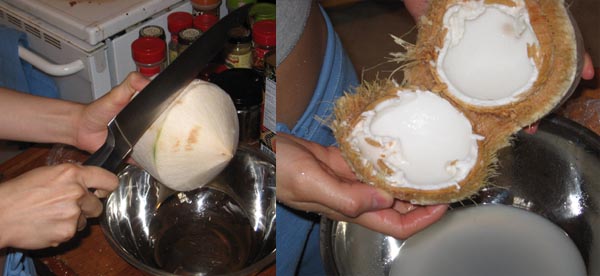
Strain the coconut water to remove any bits of husk that made its way into the bowl. Depending on the coconut, there can be anywhere from a 1/2 cup to a cup of coconut water. Then scoop out the flesh of the coconut by scraping the insides with a spoon or knife. Rinse the coconut meat if necessary to remove any bits of the hull that remain and then toss the coconut meat into a food processor and chop finely to acquire fresh shredded coconut. I was using a younger coconut because it has a sweeter coconut water, so there was not too much meat, about 3 ounces.
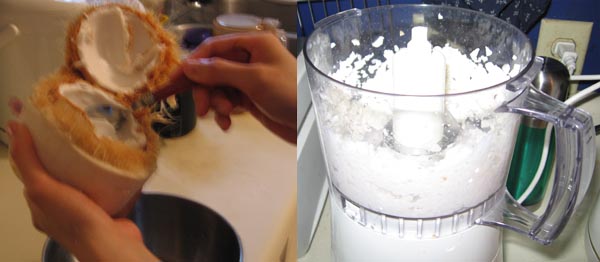
To make all of today's featured recipes, 2 or 3 coconuts would be needed (perhaps only 1 or 2 if using an older coconut with more meat). I only bought one coconut so used the fresh meat for the ice cream and bagged for the other applications. Another way to acquire coconut water and flesh if you do not want to mess with the whole coconut would be to look for these frozen drinks that come packed with the coconut meat.
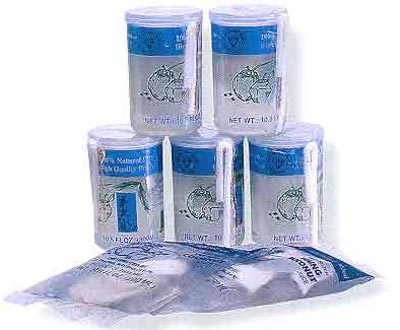 Now to start putting some things together...Nuoc mam cham: Dipping fish sauce
Now to start putting some things together...Nuoc mam cham: Dipping fish sauce. It's hard to avoid making this sauce when working with Vietnamese food! Use the ingredient measures flexibly, as the balance of flavors is often a matter of personal preference. Using coconut water instead of water adds an extra bit of depth to the dip. I used less sugar than usual because the coconut water is already sweet.
Ingredients: 1 Tb fish sauce, 1 Tb lime juice, 2 tsp sugar, 1 Tb sambal chili sauce, 1 garlic clove minced, 1/2 cup fresh coconut water.
Whisk all of the ingredients together, then adjust ingredients to your taste.
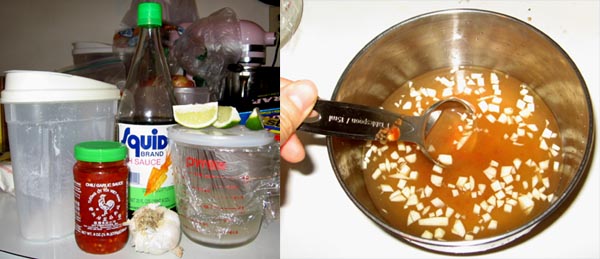 Coconut ice cream
Coconut ice cream.
Ingredients: 1 1/2 cups half-and-half, 1/2 cup coconut cream, 1/2 cup to a cup of shredded coconut (I just used what I gathered from the coconut), 4 egg yolks, 4 1/2 oz. sugar (128 g, about 1/2 cup + 2 Tb), optional 1/2 tsp vanilla extract.
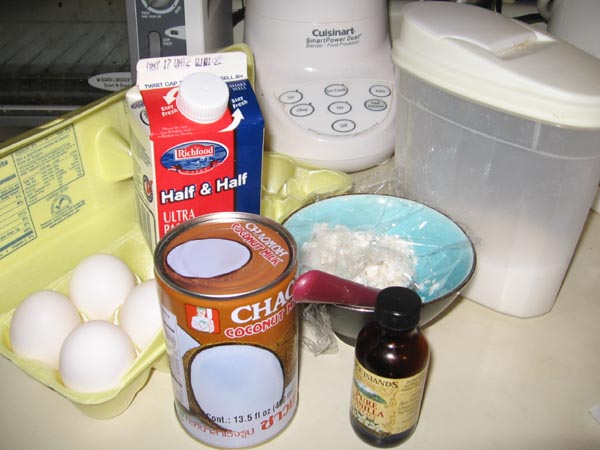
To acquire the coconut cream, take a can of coconut milk, and skim off the more solid portion that is resting on top. This thicker portion is the cream (the rest of today's recipes do not require separating out the cream, just mix the contents of the can thoroughly in those other cases). Combine the half-and-half, coconut cream, and shredded coconut in a saucepan over medium heat. Stir occasionally until the mixture reaches a simmer, then remove the pan from the heat. Separate the egg yolks and set aside the whites.
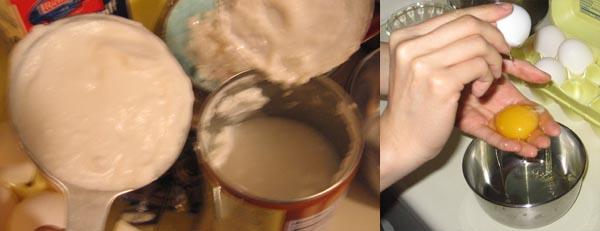
While the dairy-coconut mixture is heating up, whisk the egg yolks until they are a pale yellow.
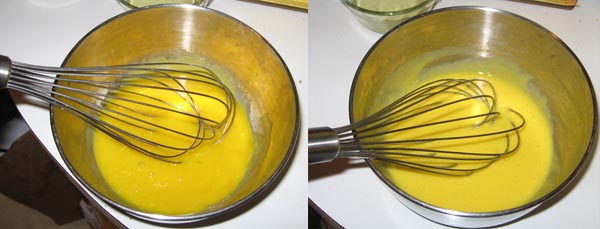
Once the color lightens, gradually add the sugar and continue whisking until you achieve a thick ribbony texture.
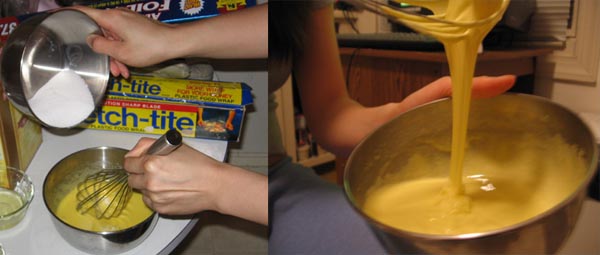
When the two components are done, add small amounts of the dairy mixture into the eggs, still whisking. This slow addition keeps the eggs from curdling by gradually raising the heat. Once about a third of the dairy mixture has been added to the eggs, the egg mixture can safely be added into the saucepan. On low heat, cook the mixture while stirring frequently until it thickens enough to coat the back of a spoon and reaches 170-F. It looks a little chunky because of the shredded coconut, but otherwise would be thickened, creamy, and smooth. It adheres to the spoon and does not drip off.
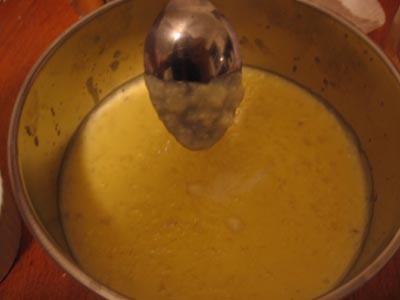
Pour everything into a container and let it cool at room temperature for half an hour. Vanilla can be added at this point if desired, I felt the flavor of the coconut was strong enough not to need any. Cover the container and place it in the fridge until it is thoroughly chilled. If it's still pretty hot and condensation would form on the cover, let the mixture cool down in the fridge for half an hour before covering. Check back after a total of four hours to see if everything is thoroughly chilled, though it can take longer. The custard is then ready to become ice cream. Follow the instructions for the ice cream maker. I have a low-key Panasonic that just goes into the freezer. All it does is it stirs the mixture periodically, so if you do not have an ice cream mixture but really want that homemade ice cream, simply put your custard in the freezer and give it a stir as often as you have the diligence for.
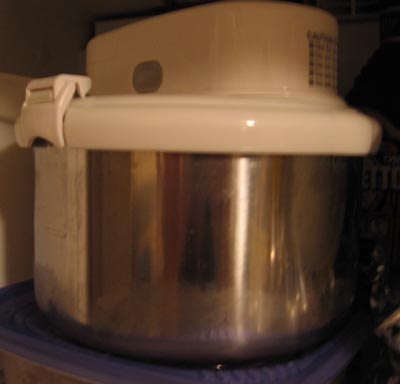
Once done, the ice cream can be eaten soft-serve. Otherwise, transfer everything into the final ice cream container and let it harden in the freezer for a few more hours.
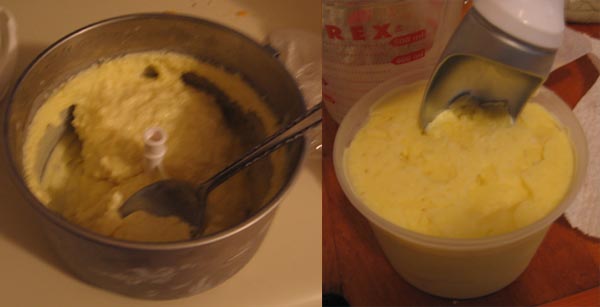 Macaroons
Macaroons. With the egg whites left from the ice cream, why not make macaroons?
Ingredients: 3/4 cup shredded coconut, 1 1/2 cups powdered sugar, 2 egg whites at room temperature, 1 Tb sugar. These measurements are approximate, the best bet is to go by weight at a ratio of 1 coconut : 2 sugar : .75 egg white. Just use a small amount of the sugar portion for beating with the egg whites, using granulated, and the rest should be powdered sugar to mix with the coconut. My specific weight measures were 86 g coconut (after toasting), 160 g powdered sugar, 65 g egg white, 13 g granulated sugar.

Toast the coconut in the oven at 325-F until a nice golden brown. The coconut can burn quickly so be sure to keep an eye on it. When the coconut begins to fill the house with its fragrance, that is a good sign to pay attention most carefully. Leave the oven on for the cookies. When the coconut has slightly cooled, grind it finely. A spice grinder or coffee mill would work very well. I used my mini party blender.

Mix together the coconut with the powdered sugar. Then, making sure the egg whites are at room temperature for maximum volume, whip them with the granulated sugar until they form semi-stiff peaks.

Fold the coconut and sugar mixture into the whites. The batter should be fairly thick but still fluid.
Load the mixture into a pastry bag and pipe 1 1/2 inch dollops about 1 inch apart on a baking sheet lined with a silpat or parchment paper. My batch made 25 cookies.

After letting the piped batter sit for half an hour, bake for 15 minutes. After coming out of the oven, let the cookies rest for a few minutes before transferring them to a wire rack to cool completely. If the macaroons break, let them cool further on the baking pan before transfer. Sticking the whole pan in the freezer works if the macaroons are resistant to removal from the pan.

I just need a couple for my desserts later, so set those aside and keep the rest around as cookies. Once cool, press two together with the flat bottoms facing each other with a buttercream or ganache filling or even some of the coconut ice cream.
 Lemongrass syrup
Lemongrass syrup. This syrup will be used later for the cocktail.
Ingredients: Equal parts sugar and water, lemongrass to taste.
Lemongrass syrup simply entails infusing some simple syrup with lemongrass. Mix some chopped lemongrass into the sugar solution in a saucepan over medium heat and let it simmer for 10 minutes. The amount of lemongrass depends on how strong of a flavor is desired. I used 1 tablespoon of lemongrass for 1/4 cup each of water and sugar (enough for two drinks).
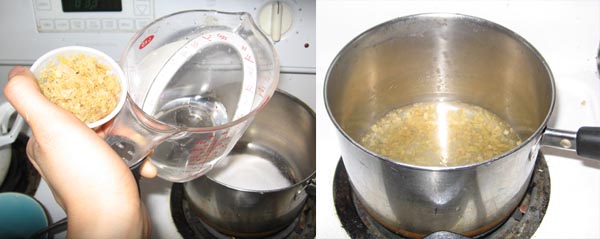
Strain out the lemongrass and store in the fridge.
Soak the mung beans. Finally, the mung beans that will be used in the crepes should be soaked for a few hours. I'm using a whole 13 oz. package. Just cover the beans with enough water to submerge them.
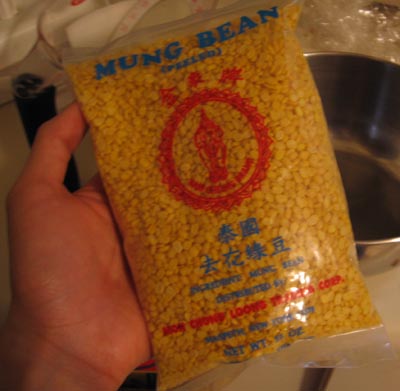 The next day...Banh xeo
The next day...Banh xeo.
Batter ingredients: 3 cups rice flour, 1 tsp sugar, 1/2 tsp salt, 1 Tb turmeric, 1/2 tsp curry powder, 3 cups water, 14 oz. coconut milk, 1/2 cup sliced scallions. Makes about 18 crepes which is enough for at least six people, I made a half batch.
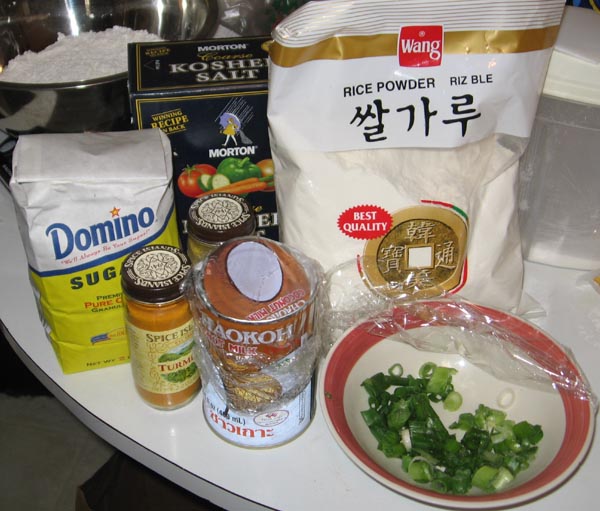
Alternatively, a pre-mixed bag of banh xeo flour can be used for the rice flour and sugar. It'll come with its own turmeric packet, but use the same amounts of salt, liquid, and scallions.
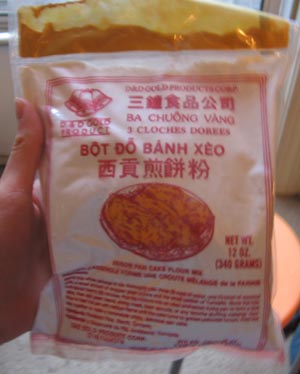
Filling: Amounts depend on how many crepes will be made. Each crepe requires 1/3 oz. mung beans (not pictured), 2-3 large shrimp, 1/4 cup onions, 1/4 cup straw mushrooms, 1/3 cup bean sprouts (not pictured), oil for frying. For every six shrimp use 2 Tb tapioca starch, salt and pepper to taste, 1 egg white, and a 1/2 cup shredded coconut.

Lettuce and herb platter: Lettuce, basil, cilantro, mint.
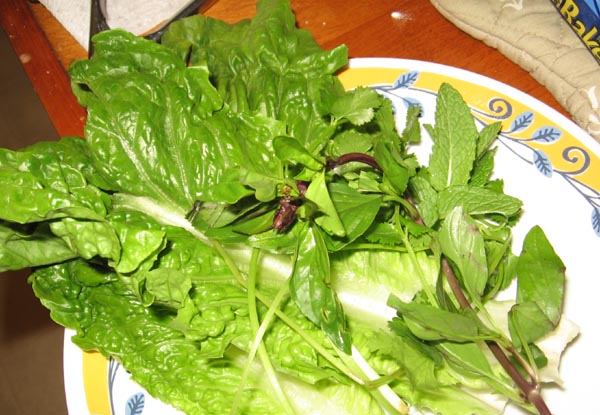
Prepare the batter by mixing all the ingredients until just combined. Stir in the scallions last. Then set everything aside to rest for about half an hour. I forgot to take a picture, but it will be fairly thin and will be a pale yellow.
Meanwhile, drain the mung beans and place them in a pot with enough water to cover them over high heat (about 2 cups of water for 6 oz. of mung beans). Keep the pot uncovered and bring the beans to a boil for 2 minutes, then reduce the heat and simmer for 30 minutes or until the beans are tender. It can take a shorter amount of time if the beans were soaking earlier. The water should be all or mostly absorbed, though if beans soaked for a longer period of time, they may not absorb as much water in this boiling process. I like these steamed rather than boiled a little more as they retain their shape better and have a firmer texture, but I went with boiling to cut down on some steps, since I had to boil the beans for the mung bean pudding as well. Mine got a bit mushy but are still okay.
Slice the onions and saute them in a little oil with the mushrooms. Season lightly with some salt or fish sauce and set aside.
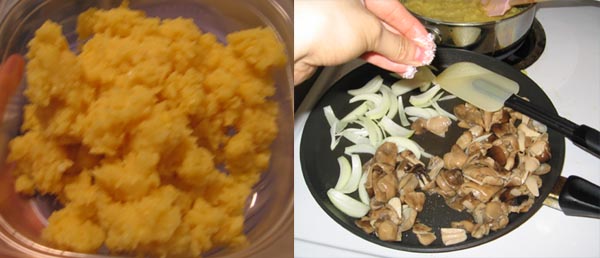
Peel and devein the shrimp. Combine the cornstarch and seasonings. Beat the egg white, and spread the coconut on a plate.

Dredge the shrimp by dipping into the cornstarch mixture, then into the egg white, then coating with the coconut. Fry the shrimp in some hot oil. Fry for 2 minutes, then flip and fry for 1 more minute. Set aside to drain.

With the batter and fillings ready, it is time to make the crepes. Make sure the lettuce platter and dipping fish sauce is ready to go, as the crepes are best eaten hot off the pan.
Heat up a frying pan over medium high heat until a few drops of water sprinkled into the pan dance around the pan but do not immediately sizzle and evaporate. Coat the bottom of the pan with some oil and once the oil is hot, ladle in about a 1/4 cup of banh xeo batter and swirl the pan to spread the batter evenly. After half a minute to a minute, spoon a couple tablespoons of the mung beans onto one half of the crepe. Top with the onions, mushrooms, bean sprouts and the shrimp.
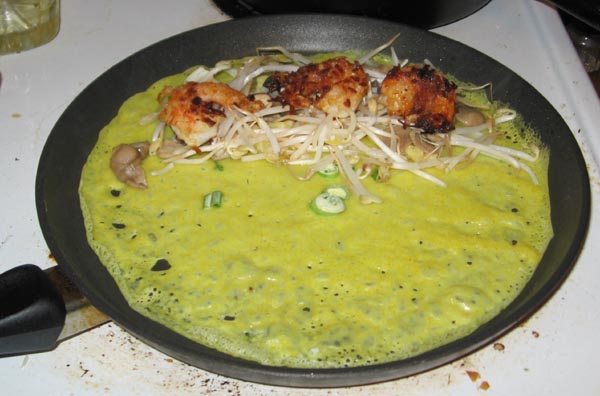
Put a cover over the pan if available or a tent of aluminum foil to help steam the bean sprouts. If you prefer the bean sprouts to be crisp, do not cover and add the bean sprouts later during the cooking process. After 5 minutes, the bottom of the crepe should be fairly crisp and the bean sprouts starting to wilt. Use a spatula to fold over the crepe.
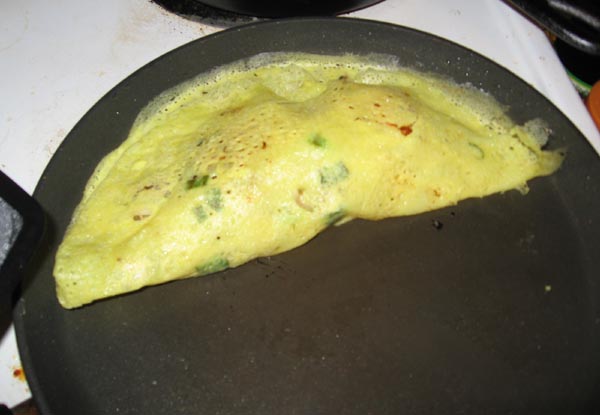
After 30 more seconds in the pan, slide onto a plate. Eat by wrapping pieces of the crepe in lettuce with some of the herbs and dip in the fish sauce. Because the crepes are best directly off the pan, the number of pans and burners limits how many can be made at once. At home, my mom cooks two at a time and calls us individually to the table when each is finished. It's about the only meal for which my mom doesn't require everyone to sit down together as a family to eat.
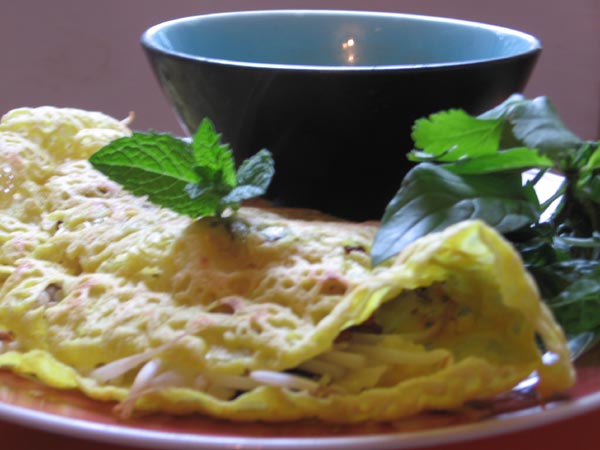
Going in for the bite...
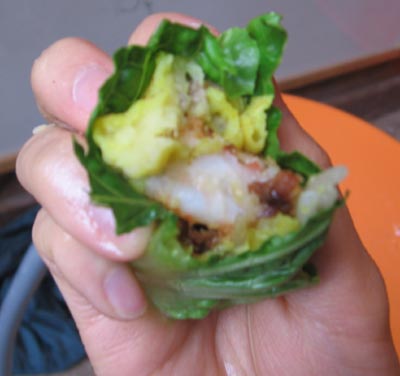
As mentioned, banh xeo is traditionally made with pork and shrimp that has just been boiled, with no or little seasoning. The battering with coconut of the shrimp turned out really well, and the shrimp even could have been eaten on their own. They retained a bit of their crunch even within the crepes which was very appealing to me as I like to cook my banh xeo until they are fairly crispy and browned. I'm not sure if I'd like the nuoc cham dipping sauce made with coconut water in everyday use, but it worked well with the banh xeo since there were already some coconut flavors in the food.
Some more notes on the filling.. Boiled pork belly and shrimp is the most common, though usually I do marinate the meat in a bit of sugar and fish sauce (or salt) and cook that in a bit of oil. I also showed mine with the filling all piled on one side of the crepe. That makes it easier to fold, but if you are careful, you can even scatter everything throughout the crepe and fold, achieving one with more evenly distributed filling. Yet another variation is to not cook the onion, meat, and shrimp first. Scatter the proper amount over your pan, and when cooked through, ladle on your batter. Then just fill with mung bean, mushroom, and bean sprouts. Doing this melds the batter with the meat/onion portion, though the crepe may not appear as smooth. I often do this with just the onions, as their appearance throughout the yellow batter can be very pretty.
Now for dessert....
Mung bean pudding.
Ingredients: 7 oz. dried yellow mung beans, 2 cups water, 1/2 cup sugar, 7 oz. coconut milk.
The cooking process for the mung beans starts off identically to the one used for the banh xeo. After the mung beans have been soaked, drain and rinse the beans. Place in a pot over high heat with the water and bring to a boil. Once the water boils, let it boil for 2 minutes, then lower the heat to a simmer, and let the beans cook uncovered for half an hour or until the beans are soft. I saved a step and have this already completed by cooking enough mung beans for the dessert when I cooked them for the banh xeo filling.
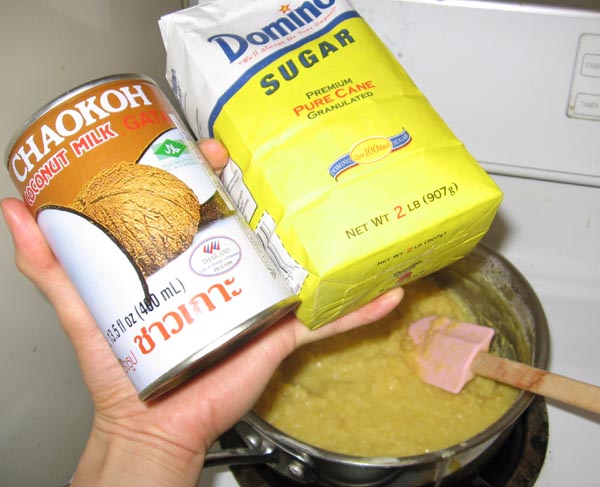
Once the mung beans are cooked, simply stir in the coconut milk and sugar and let everything simmer for at least five minutes.
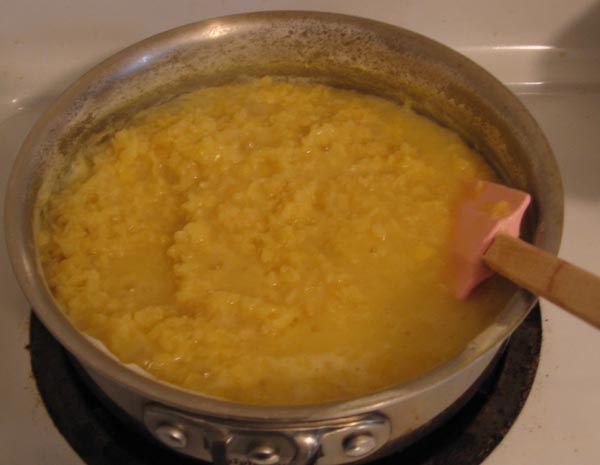 Crepes
Crepes. The crepe batter is best prepared beforehand to let sit in the refrigerator, allowing for the bubbles to redistribute and settle. Mix the batter before the main course and have it ready to go once it is time for dessert or even prepare it the night before.
Ingredients: 1 egg, 1/4 cup milk, 1/4 cup water, 1/2 cup flour, 1 Tb sugar, 1 1/2 Tb melted butter, 2 Tb coconut milk, 1/2 tsp vanilla, some extra butter.
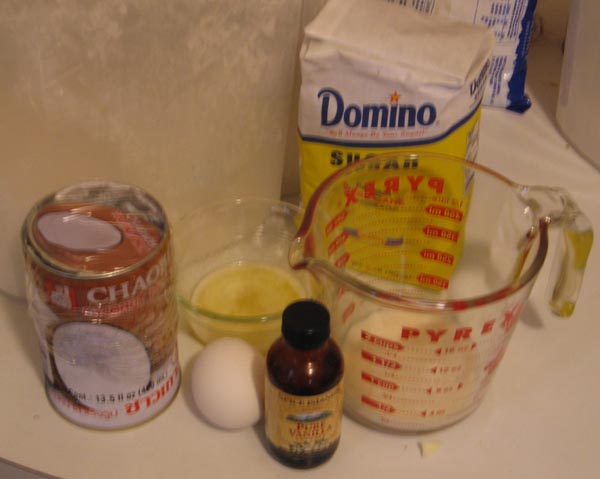
Combine all of the ingredients except for the extra butter. When the batter is ready, heat the pan just as was done for the banh xeo. Once hot, melt some butter in the pan to coat it. Ladle in an ounce of crepe batter and swirl it evenly across the pan. After 30 seconds, flip and cook for 10 more seconds. Don't worry if the first one or two break, by the third one, the pan should be evenly hot enough to cook perfect crepes. Lay out the completed crepes on a flat surface.
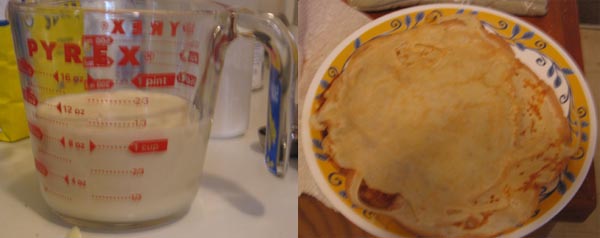 Fried banana
Fried banana. I would have liked to use taro instead but didn't get a chance to acquire some, but the banana works as well.
Ingredients: 2 Tb rice flour, 2 tsp tapioca starch, 1/2 tsp sugar, 1/8 tsp salt, 1 Tb shredded coconut, 2 Tb water, 1 banana, enough oil to fry.
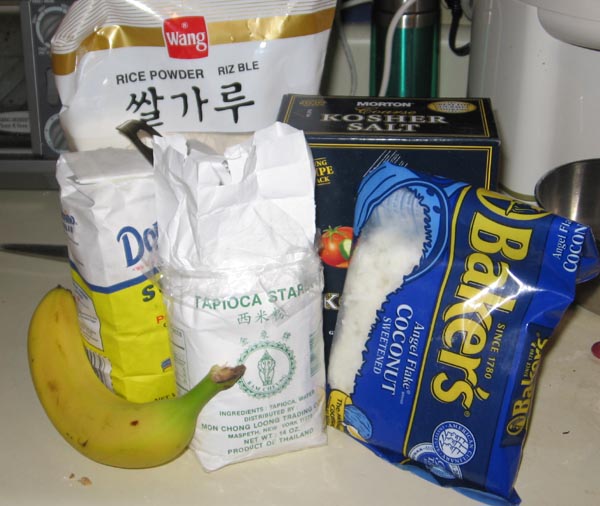
Mix together all of the ingredients except for the banana and oil. Peel the banana and cut it into 1/2" slices, then coat them in the batter.
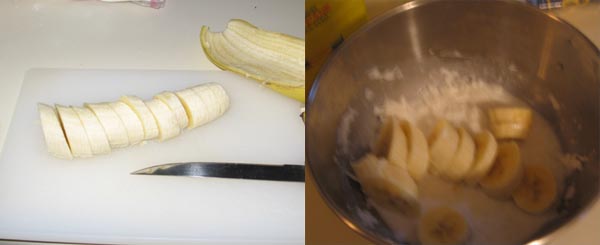
Fry in hot oil until golden in color, then drain.
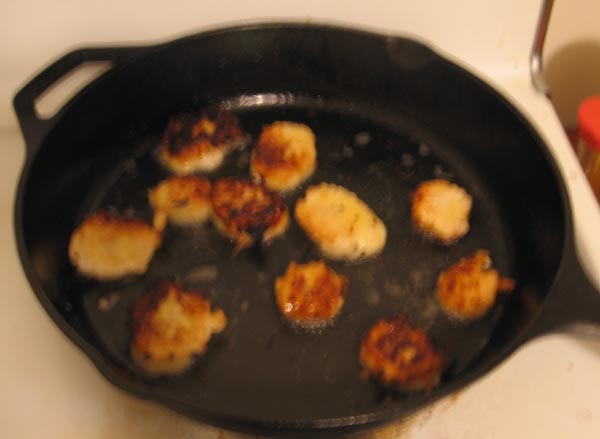 Assembly
Assembly. Spoon a couple tablespoons of mung bean pudding onto a crepe, then fold the crepe into quarters. Arrange a couple of these crepes on a plate. Spoon on a scoop of the coconut ice cream, then place on a macaroon and fried banana. If you have lime on hand, grate some zest on the ice cream and crepes to provide a contrasting tang to the sweetness of all that coconut goodness.
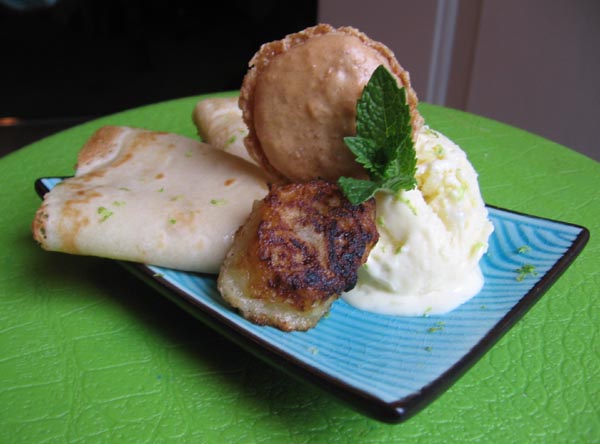 Coconut lemongrass cocktail
Coconut lemongrass cocktail. Okay, so there is one more form of coconut.. coconut rum!
Ingredients: 1 1/2 oz. coconut rum (regular light rum works just as well, in retrospect I would prefer it because the coconut water and syrup provide enough sweetness and of course it would be a stronger drink!), 1 oz. coconut water, 1 oz. lemongrass syrup, 1 1/2 oz. lime juice.
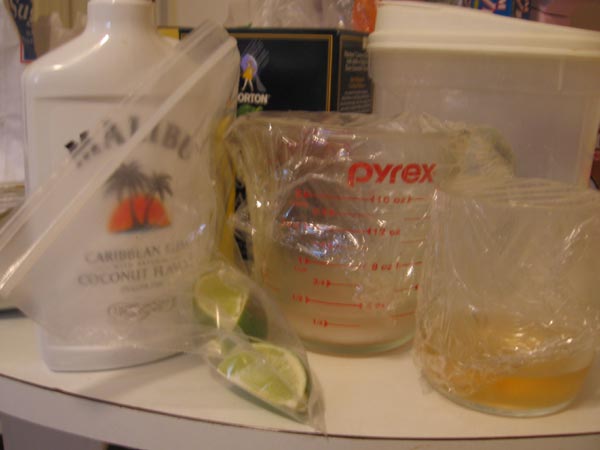
Mix all of the ingredients with some ice until chilled. Strain and serve in a cocktail glass or for fun, in the coconut shell. Garnish with some lime.
